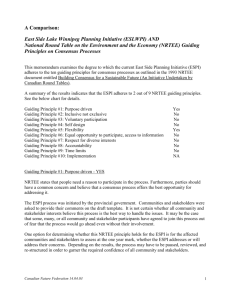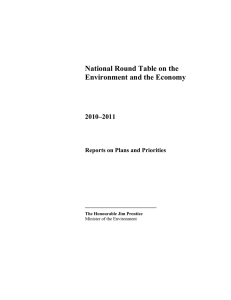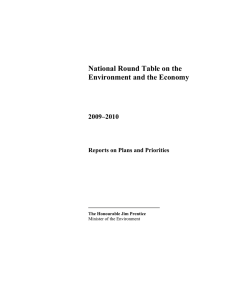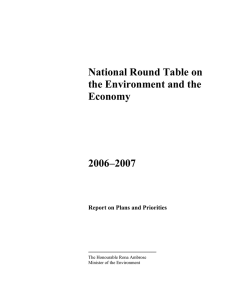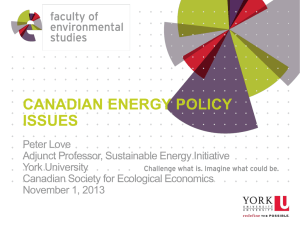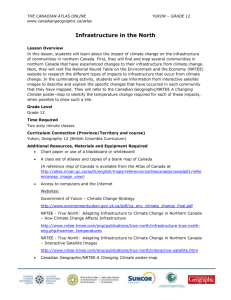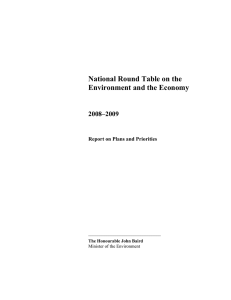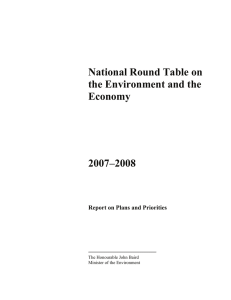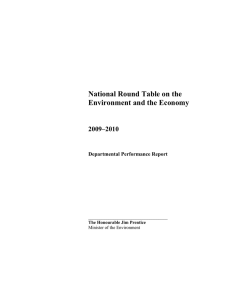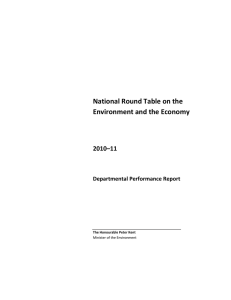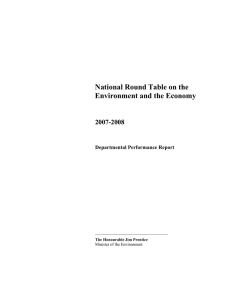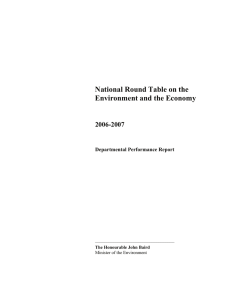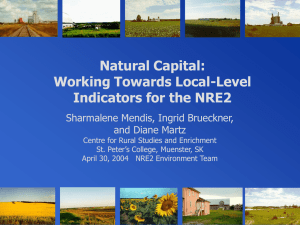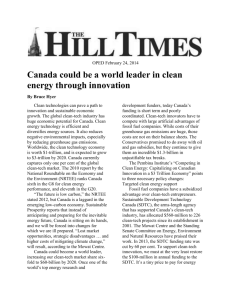National Round Table on the Environment and the Economy 2008–2009
advertisement
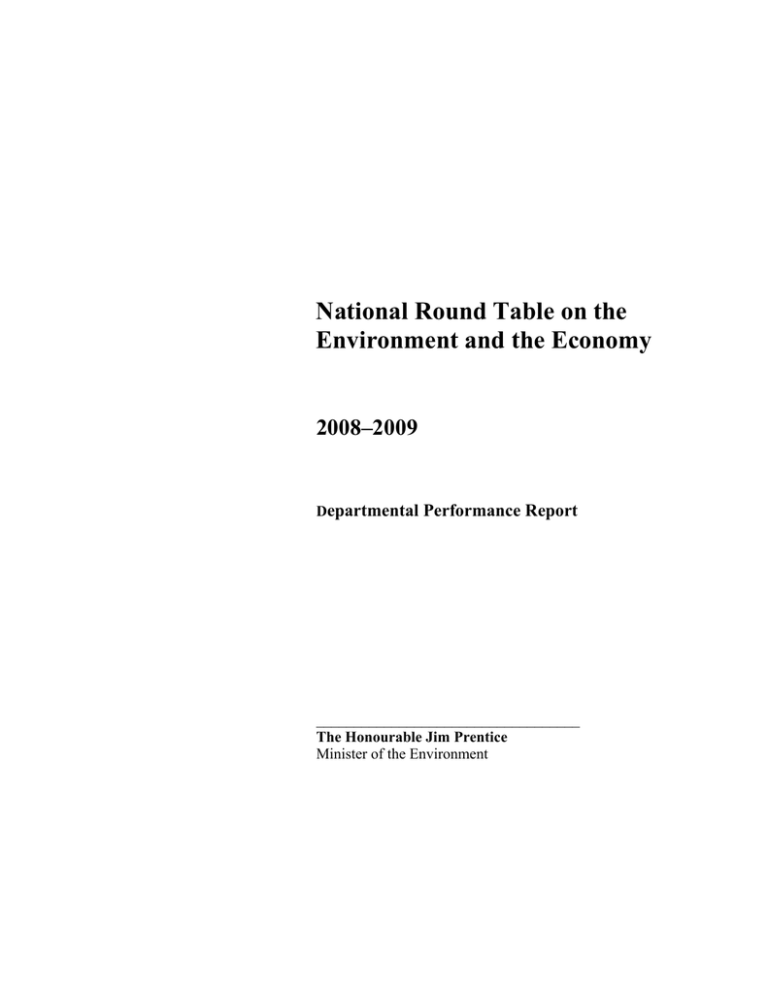
National Round Table on the Environment and the Economy 2008–2009 Departmental Performance Report ___________________________________ The Honourable Jim Prentice Minister of the Environment Table of Contents Message from the President and CEO ............................................................................. i Section 1: Agency Overview..............................................................................................1 1.1 Summary Information................................................................................................1 Raison d’Être and Responsibilities ............................................................................1 1.2 Strategic Outcome......................................................................................................3 Program Activity Architecture (PAA).......................................................................3 1.3 Performance Summary ..............................................................................................3 Financial Resources ...................................................................................................3 Human Resources ......................................................................................................3 Planning Summary.....................................................................................................4 1.4 Contribution of Priorities to Strategic Outcome ........................................................4 1.5 Risk Analysis .............................................................................................................5 Context.......................................................................................................................5 Risk Factors ...............................................................................................................5 1.6 Expenditure Profile ....................................................................................................6 1.7 Voted and Statutory Items .........................................................................................6 Section 2: Analysis of Program Activity by Strategic Outcome ....................................7 2.1 NRTEE Strategic Outcome........................................................................................7 The NRTEE Performance Measurement Framework................................................8 2.2 Program Activity Summary .......................................................................................8 Produce Advice..........................................................................................................8 Promote Advice .......................................................................................................10 Apply Sound Management Practices.......................................................................12 2.3 Summary of Performance by Indicator....................................................................13 2.4 Feedback ..................................................................................................................14 Feedback from Survey of Federal Decision Makers and Members.........................14 Results of Other Surveys .........................................................................................14 2.5 Benefits for Canadians.............................................................................................15 2.6 Performance Analysis ..............................................................................................16 2.7 Lessons Learned ......................................................................................................16 Section 3: Supplementary Information..........................................................................17 3.1 NRTEE Financial Highlights...................................................................................17 3.2 NRTEE Financial Statements ..................................................................................17 Section 4: Other Items of Interest ..................................................................................19 4.1 NRTEE Stakeholders and Their Expectations.........................................................19 4.2 NRTEE Members ....................................................................................................20 4.3 NRTEE Contact Information ...................................................................................21 Message from the President and CEO This past year was particularly busy for the National Round Table on the Environment and the Economy (NRTEE or Round Table). The agency released four major reports related to its work and held extensive research and consultation meetings across the country on various issues. We also marked our 20th anniversary in 2008 with a unique forum called Securing Canada’s Future in a Climate-Changing World. It consisted of three roundtable sessions with Canadian leaders in sustainability discussing Canada’s environmental and economic security as seen through the lenses of Canada’s ecosystems, energy economy, and Arctic environment. The resulting report, Climate Forward: A Next Step Policy Agenda for Canada, was published in June 2009. The NRTEE continued its focus and research on the critical issue of climate change, addressing it from a number of perspectives. In early 2009, the NRTEE released Geared for Change: Energy Efficiency in Canada’s Commercial Building Sector, a collaborative report with Sustainable Development and Technologies Canada (SDTC). This joint report set out a policy pathway and recommendations to overcome barriers to technology deployment that would improve the energy efficiency of commercial buildings and cut greenhouse gas (GHG) emissions. Throughout 2008 and the winter of 2009 the NRTEE conducted original research and held national and regional stakeholder consultations on how carbon pricing can help Canada meet the federal government’s GHG emission reduction targets for 2020 and 2050. The results were published in April 2009 as Achieving 2050: A Carbon Pricing Policy for Canada, which recommended an economy-wide cap-and-trade system to meet environmental targets at least economic cost. The NRTEE fulfilled its obligations under the Kyoto Protocol Implementation Act (KPIA), to undertake a review and assessment of the government’s 2008 KPIA Action Plan. A companion report, Greenhouse Gas Emissions Forecasting: Learning from International Best Practices, was released to provide additional guidance to policy makers. In the summer of 2008 we released an advisory note to the Minister of the Environment entitled Developing Ambient Air Quality Objectives for Canada. The note completed the NRTEE’s work in response to the Government of Canada’s request for advice on longterm climate change and clean air strategies for Canada. The NRTEE commenced initial research and scoping work on two major new programs it will be undertaking over the next fiscal year: Water Sustainability and the Future of Canada’s Natural Resource Sectors and Economic Risks and Opportunities of Climate Change for Canada. A major expert workshop on water was held in February 2009 with a summary report of proceedings made public. Feedback from an independent third party survey, conducted as part of the performance measurement process, confirmed the high quality, relevance, and usefulness of the work of the NRTEE. Message from the President and CEO i The NRTEE’s website was redesigned to create a communications tool more useful and accessible to visitors, stakeholders, as well as NRTEE members. Our “single window” service approach to members continues to improve with a Members’ Corner site for planning and research. A stronger emphasis was placed on the electronic distribution of reports, with a resulting significant increase in publication downloads and cost efficiencies. Previously initiated internal organizational realignments were finalized, leading to a stronger capacity for policy and research, communications, and corporate services. Over two decades, the NRTEE has developed unique expertise that well positions it to provide a unique and needed contribution to Canadian sustainable development policy. By working closely with our many stakeholders, we will continue to provide useful, timely, and relevant research and policy advice to the federal government, parliamentarians, governments across Canada, and all Canadians. __________________________________ David McLaughlin NRTEE President and CEO ii National Round Table on the Environment and the Economy Section 1: Agency Overview 1.1 Summary Information Raison d’Être and Responsibilities The raison d’être, or purpose, of the National Round Table on the Environment and the Economy (NRTEE or Round Table) is to play the role of catalyst in identifying, explaining, and promoting, in all sectors of Canadian society and in all regions of Canada, principles and practices of sustainable development. The NRTEE interprets this broad mandate through a strategic focus on issues of national interest at the intersection of the environment and the economy. It examines the environmental and economic implications of priority issues and offers independent advice on how to address them. Through its work, the NRTEE strives to influence policy development and decisions on issues pertaining to the environment and the economy. These promote economic prosperity for all Canadians while striving to preserve the environment for current and future generations. Legislative Purpose (a) undertaking research and gathering information and analyses on critical issues of sustainable development; (b) advising governments on ways of integrating environmental and economic considerations into their decision-making processes and on global issues of sustainable development; (c) advising those sectors and regions on ways of incorporating principles and practices of sustainable development into their activities; (d) promoting the understanding and increasing public awareness of the cultural, social, economic, and policy changes required to attain sustainable development; and (e) facilitating and assisting cooperative efforts in Canada to overcome barriers to the attainment of sustainable development. National Round Table on the Environment and the Economy Act, Section 4 Created in 1988 by the Prime Minister, the NRTEE is an independent national advisory body reporting to the federal government and Parliament through the Minister of the Environment (see Figure 1 for the agency’s internal organization and relationship to the Section 1: Agency Overview 1 federal government). The Round Table had its status formalized in a 1993 Act of Parliament, Bill C-72, An Act to establish the National Round Table on the Environment and the Economy (NRTEE Act). The NRTEE is a departmental corporation (Financial Administration Act, Schedule II). The work of the NRTEE is directed by the Round Table members drawing on their expertise and insight. The members are part-time Governor-in-Council appointees. They represent different regions of Canada and are distinguished leaders from business, labour, universities, public service, and environmental organizations. A complete list of the NRTEE’s members can be found in section 4.2. The Round Table normally meets four times each year in plenary sessions where members discuss priorities and review and approve the work of the Secretariat. A Secretariat in Ottawa, headed by a President and CEO, supports the members. In this context, the Secretariat provides program management, policy and research analysis, communications, and administrative services to the NRTEE members. General information about the NRTEE and its membership can be found on the agency’s website at www.nrtee-trnee.ca Figure 1: NRTEE internal organization and relationship to the federal government 2 National Round Table on the Environment and the Economy 1.2 Strategic Outcome As approved by the Treasury Board of Canada Secretariat (TBS) in June 2007, the NRTEE has a single Strategic Outcome and a single program activity, which the NRTEE strives to achieve in the effective pursuit of its mandate. It is as follows: Federal policy development and decisions in other key sectors are influenced by advice on sustainable development issues pertaining to the environment and the economy. Program Activity Architecture (PAA) Figure 2 illustrates the NRTEE’s framework for its program activity, contributing toward the Agency’s single Strategic Outcome. Figure 2: Program Activity Architecture (PAA) — National Round Table on the Environment and the Economy Strategic Outcome Federal policy development and decisions in other key sectors are influenced by advice on sustainable development issues pertaining to the environment and the economy. Program Activity Advisory Program on environment and economy issues 1.3 Performance Summary Financial Resources Table 1: Financial Resources Summary, 2008–2009 ($ thousands) Planned Spending Total Authorities Actual Spending 5,154.0 5,598.2 5,051.6 Human Resources Table 2: Human Resources Summary, 2008–2009 (FTEs) Planned Actual Difference 27 28 1 Section 1: Agency Overview 3 Planning Summary Table 3: Planning Summary, 2008–2009 ($ thousands) Strategic Outcome: Federal policy development on environment and economy issues and decisions in other key sectors are influenced by NRTEE advice on selected issues Performance Indicators: 2008–09 Performance: The extent to which NRTEE’s advice is considered in federal policy decisions and its research results are used in developing policy recommendations Stakeholder feedback indicates NRTEE research to be generally high quality, timely, relevant and useful, which supports the Strategic Outcome 2008–09 Actual Spending 2007–08 Main Estimates Planned Spending Total Authorities Actual Spending Advisory program on environment and economy issues 4,857.7 5,154.0 5,154.0 5,598.2 5,051.6 Total 4,857.7 5,154.0 5,154.0 5,598.2 5,051.6 Program Activity Alignment to Government of Canada Outcomes Strong economic growth 1.4 Contribution of Priorities to Strategic Outcome Table 4 illustrates the contribution of the NRTEE to its two key areas of priority as identified in the NRTEE’s 2008–2009 Report on Plans and Priorities (one operational and one management) toward its single Strategic Outcome. Table 4: Contribution of Organizational Priorities toward Strategic Outcome, 2008–2009 4 Priority 1: Operational Priorities Type Status Comment Produce and promote advice to decision makers on environment and economy issues Ongoing Mostly met Operational priorities were achieved in 2008-09 with minor exceptions. For specific details achievements, see section 2.2 Priority 2: Management Priorities Type Status Comment Apply sound management practices in operations Ongoing Mostly met Management priorities were achieved in 2008-09 with minor exceptions. For specific details on achievements, see section 2.2 National Round Table on the Environment and the Economy 1.5 Risk Analysis Context Issues and risks to be examined by the NRTEE are identified through an internal screening and scoping process, in which the final decisions reflect current political, environmental, or economic priorities, and members’ combined interests. The NRTEE has adopted an approach to its work that effectively balances stakeholder consultation with a reliance on members’ expertise and advice, and in-house research analysis capacities. Risk Factors The NRTEE strives to influence the government’s approach to important sustainable development issues. To accomplish this, the NRTEE must produce and promote relevant, neutral, and credible advice in a timely manner. Its ability to do so is affected by both external and internal factors. Changes in operating environment have been, and will continue to be, a challenge for a small agency such as the NRTEE. The agency expects to experience continuing pressures to adapt and respond over the next few years, but despite these challenges, the NRTEE remains firmly focused on providing timely advice that is credible, balanced, and relevant. Key risk factors are discussed below. • The emergence of the environment—and climate change in particular—as a key priority for Canadians has put the Round Table firmly in the spotlight due to the focus of its current work. This created both an opportunity and a risk. In 2008–2009, the focus of the NRTEE’s research and analysis and resulting policy advice was on this critical issue. This topic remains controversial in many circles, being the subject of policy debates both in Canada and internationally. In order to be credible in this situation, the NRTEE needs to achieve a balance between generating advice that is relevant and useful to the government in the short term, and yet is also relevant for the future. The NRTEE understands this complex environment well and manages the associated risks by producing advice that is fact-based, objective, and sound, and by consulting on an ongoing basis with its stakeholders both inside and outside government. Its communications strategy is also crafted to address this challenge. • The timing of the appointment of new members to the Round Table has, in the past, posed challenges for the NRTEE in terms of ensuring continuity for its work. In 2008–2009, no new members were appointed; thus the composition of the NRTEE’s members remained stable. Through broad consultation with stakeholders during this period, the NRTEE continued to ensure that representation from all sectors and all regions of the country was reflected in its work. • Small agencies such as the NRTEE are often vulnerable to employee turnover. Internally, the NRTEE faced particular challenges in 2008–2009 due to the departure of some senior staff in its policy, communications, and operations units. The vacancies created by these departures were quickly and adequately filled through internal promotions and other short-term arrangements. Through continual Section 1: Agency Overview 5 operational efficiencies and adequate planning, the NRTEE has continued to succeed in delivering on its stated priorities. 1.6 Expenditure Profile In 2008–2009, the Round Table’s spending was $5.052 million. In this period, there were no transfer payment programs or significant shifts in statutory spending. 1.7 Voted and Statutory Items Table 5 illustrates the way in which Parliament approved the NRTEE’s resources, and shows the changes in resources derived from Supplementary Estimates and other authorities, as well as how funds were spent. Table 5: Voted and Statutory Items ($ thousands) 2008–09 Vote # or Statutory Item (S) Truncated Vote or Statutory Wording 20 Operating expenditures (S) Contributions to employee benefit plans (S) Expenditures pursuant to Paragraph 29.1 (1) of the Financial Administration Act Total 6 Actual Spending 2006–07 Actual Spending 2007–08 Main Estimates Actual Spending 4,240.0 4,517.7 4,723.0 4,695.6 294.3 339.1 411.0 356.0 0.9 0.9 20.0 0 4,535.2 4,857.7 5,154.0 5,051.6 National Round Table on the Environment and the Economy Section 2: Analysis of Program Activity by Strategic Outcome 2.1 NRTEE Strategic Outcome As previously outlined in section 1.2, the NRTEE has a single Strategic Outcome as approved by the Treasury Board of Canada Secretariat (TBS). It is as follows: Federal policy development and decisions in other key sectors are influenced by advice on sustainable development issues pertaining to the environment and the economy The key indicator of the NRTEE’s overall performance against its Strategic Outcome is the extent to which NRTEE’s advice is considered in federal policy decisions and its research results are used in the development of policy recommendations. The Program Activity that pertains to this Strategic Outcome is: Advisory Program on environment and economy issues The NRTEE’s approach to achieving its Strategic Outcome consists of producing and promoting its policy advice, and, in all aspects of its work, applying sound management practices. The NRTEE’s goal is to increase the understanding of decision makers about challenges and opportunities at the interface of the environment and the economy, and to inform the debate on those questions. The NRTEE is in the unique position of being an independent policy advisory agency that advises the federal government on sustainable development solutions. It raises awareness among Canadians and their governments about the challenges of sustainable development by advocating for positive change and strives to promote credible and impartial policy solutions that are in the best interest of all Canadians. During 2008–2009, the NRTEE engaged federal departments, agencies, and key national, provincial, and territorial stakeholders in our research and ideas generation. Throughout the course of its work, the NRTEE has continued to suggest ways to make environmental and economic concerns a central plank of the government’s decision-making processes and encourage the adoption of its recommendations. Section 2: Analysis of Program Activity by Strategic Outcome 7 The NRTEE Performance Measurement Framework The performance measurement framework, presented in Figure 3, identifies the performance indicators for the single Strategic Outcome and each result and output contributing to this outcome. Figure 3: NRTEE Performance Measurement Framework 2.2 Program Activity Summary The summary that follows reflects the three core areas of NRTEE activity: Produce Advice, Promote Advice, and Apply Sound Management Practices. The expected results for each of these three core activities, outlined below, are in accordance with the NRTEE’s Performance Measurement Framework, as illustrated in Figure 3. Produce Advice Producing advice entails conducting original research, convening experts and stakeholders to ensure balance and credibility. The research analyzes the environmental and economic facts and trends underlying each issue. The resulting policy recommendations are reviewed and approved by NRTEE members. The culmination of this effort is a report that presents the findings, analysis, and recommendations from the research and consultation process and the consensus of members. 8 National Round Table on the Environment and the Economy Expected Results and Outputs (as illustrated in Figure 3: NRTEE Performance Measurement Framework) • • • Usefulness of policy advice and recommendations Quality of policy research Effectiveness of stakeholder consultations (a) Generate Policy Advice In 2008–2009, the NRTEE successfully undertook a variety of activities through a range of targeted initiatives to achieve its expected results. • Developing Ambient Air Quality Objectives for Canada: This advisory note released in June 2008 completed the NRTEE’s work in response to the Government of Canada’s request for advice on long-term climate change and clean air strategies for Canada, as set out in the government’s Regulatory Framework for Air Emissions (April 2007). • Greenhouse Gas Emissions Forecasting: Learning from International Best Practices: In this publication released in 2008, the NRTEE offered lessons on how Canada can continue to improve its approach to emissions forecasting. The report examined how other countries approach similar forecasting challenges to those faced by the federal government. • 20th Anniversary Forum entitled Securing Canada’s Future in a Climate-Changing World: On October 30, 2008, the NRTEE commemorated its twentieth anniversary by holding a forum to discuss Canada’s next steps climate policy agenda. The forum gave over 100 leading Canadians a chance to discuss how climate change would affect Canada’s ecosystems, energy economy, and Arctic environment. A report setting out what was heard at the forum and offering observations from the NRTEE for Canada’s next steps climate policy agenda, called Climate Forward, was released in the next fiscal year. • Geared for Change: Energy Efficiency in Canada’s Commercial Building Sector: The NRTEE worked collaboratively with Sustainable Development Technology Canada (SDTC) to develop a policy pathway to help maximize the use of existing technologies to reduce energy use and GHG emissions. The report represented a major step in addressing the realities facing the commercial building sector in Canada as it moves to address challenges like emissions and energy consumption. • Carbon pricing: Over 2008 and the winter of 2009 the NRTEE conducted groundbreaking research into the ways in which Canada can meet the government’s goals for greenhouse gas (GHG) reduction targets, for 2020 and 2050. The results were published in April 2009 as Achieving 2050: A Carbon Pricing Policy for Canada, which recommended an economy-wide cap-and-trade system to meet our environmental targets at least economic cost. In 2008–2009, the NRTEE did not meet its proposed deadline for completion of its report Adaptation of Northern Infrastructure to Climate Change. There were unanticipated challenges in bringing together a range of research findings into a cohesive report that Section 2: Analysis of Program Activity by Strategic Outcome 9 met both stakeholders’ and NRTEE members’ expectations. Work on this important issue has continued and the report is expected to be released in the fall of 2009. In 2008–2009, the NRTEE commenced research and scoping work on two new major multi-year policy research areas: Economic Risks and Opportunities of Climate Change for Canada, and Water Sustainability and the Future of Canada’s Natural Resource Sectors. More information about each of these specific initiatives and related reports available for download can be found on the NRTEE website at www.nrtee-trnee.ca. (b) Comply with Bill C-288 In July 2008, the NRTEE complied with its legislated responsibilities under the Kyoto Protocol Implementation Act (KPIA). This was the NRTEE’s second response to its obligations under KPIA. The NRTEE response may be found at http://www.nrtee-trnee.ca/eng/publications/KPIA2008/kpia-2008.pdf. (c) Respond to Government References In 2008–2009 the NRTEE was not called upon to respond to any government research requests. (d) Establish a Strategic Outlook Function Progress was made toward the planned establishment of a strategic outlook function. However, due to competing pressures, this has yet to be fully implemented and will be pursued in 2009–2010. Promote Advice On completion of an activity, the agency promotes its findings and advice through a variety of communications channels to reach targeted decision makers and opinion leaders across the country. This step is crucial for raising awareness and understanding and for influencing policy development. The NRTEE maintains and updates networks of selected individuals and stakeholder groups as a starting point for these activities. Expected Results and Outputs (as illustrated in Figure 3: NRTEE Performance Measurement Framework) • • Quality and reach of external communications Level of awareness and understanding by federal decision-makers and national stakeholders of NRTEE advice on selected issues (a) Maintain Program and Corporate Communications Activities Based on the performance data collected for 2008–2009, the NRTEE was successful in achieving its expected results for the fiscal year. 10 National Round Table on the Environment and the Economy Despite its limited resources the NRTEE increased its overall communications profile and activities, supporting the release of the Round Table’s reports, revamping the website with a new look and improved functionality, and communicating advice regularly and directly with stakeholders. The 20th Anniversary Forum was a major public event for the Round Table in the fall of 2008. The NRTEE communications section brought both media and public attention to the proceedings. This included full taped coverage from CPAC, allowing a wide audience across Canada to see the proceedings that were also made available on the NRTEE website. (b) Improve Strategic Communications Media relations are a key aspect of the work of the NRTEE communications team. In 2008–2009 the Round Table achieved significant presence in national and regional media both from a general corporate perspective (eight-fold from the prior year — see Table 6 for more details) and in support of its various reports, especially the 20th Anniversary Forum and Achieving 2050. Table 6: Media coverage of NRTEE policy research (2008–2009) Program or Publication Number of Media References Media Sources 20th Anniversary Forum: Securing Canada’s Future in a ClimateChanging World 25 Canadian Press (8 mentions), SRC (Radio-Canada) “Le monde selon Mathieu,” Canada News Wire “Media Day Book,” Le Journal de Montréal, SRC-Télévision, CanWest, CBC Radio “The House,” CFRA News Talk Radio, New Brunswick Telegraph-Journal, Ottawa Citizen, SRC (Radio-Canada) Sudbury “Le train du matin,” SRC (Radio-Canada) Edmonton “Le café show,” OKalaKatiget Radio Labrador, Environmental Dimensions News Report, BNA, CPAC, Environment Canada website, Le Soleil Geared for Change: Energy Efficiency in Canada’s Commercial Building Sector 17 1130 News Vancouver, Canada.com, CMHC Newsletter February Issue, CNW, Canadian Press, Edmonton Journal, Green Business News, Le Soleil, Ottawa Citizen, The Gazette (Montréal), Le Journal de Montréal, SRC (Radio-Canada) Calgary, SRC (RadioCanada) “Ontario aujourd’hui,” SRC (Radio-Canada) “Maisonneuve en direct,” EcoLog News, CBC Radio “The House” NRTEE Corporate 163 Vancouver Sun, Canadian Press, Ottawa Citizen, La Presse, Calgary Sun, Whitehorse Daily Star, Kingston Whig-Standard, Edmonton Journal, Toronto Sun, The London Free Press, Ottawa Sun, Winnipeg Sun, Red Deer Advocate, The Globe and Mail, Waterloo Region Record, New Brunswick Telegraph-Journal, Chronicle Herald, Le Soleil, The Gazette, Times & Transcript, Winnipeg Free Press, Le Devoir, The Telegram, Toronto Star, Le Journal de Montréal, Daily Gleaner, L’Acadie Nouvelle, The Guardian, Edmonton Sun, The StarPhoenix, National Post, Calgary Herald, Times Colonist, La Voix de l’Est, Le Nouvelliste (Mentions of the NRTEE and/or its members – not related to policy programs) (up from 22 in 2007–08) Section 2: Analysis of Program Activity by Strategic Outcome 11 A significant factor in this success was the focus NRTEE communications has placed on the Round Table’s website. The site was redesigned to create a tool that would be easier for stakeholders to navigate and find information by focusing on delivering targeted, relevant, and important information that is updated regularly. The website has continued to develop and improve in response to stakeholders’ needs. In conjunction with the redesign of the website, the NRTEE acted to make electronic access to its reports easier. Electronic distribution of reports has many advantages over traditional printing, saving costs and using less paper. It also makes it possible for the NRTEE to communicate its work immediately to its stakeholders. The most requested NRTEE documents in 2008–2009 were Getting to 2050: Canada’s Transition to a Lowemission Future (4275 downloads – April 2008 to March 2009), Geared for Change: Energy Efficiency in Canada’s Commercial Building Sector (2006 downloads – January to March 2009) and materials for the 20th Anniversary Forum (3068 Forum Guides and 2451 Forum Commentaries downloaded – October 2008 to March 2009). This trend toward e-publishing continues with the advisory report Achieving 2050: A Carbon Pricing Policy for Canada, which has been downloaded over 17,000 times in the fourmonth period following its release on April 16, 2009. The 120 page technical background report in support of Achieving 2050 was downloaded over 10,000 times. In direct response to feedback from stakeholders in 2007–2008 the NRTEE undertook concrete steps to raise its presence and profile in Quebec in 2008–2009. A network of approximately 15 key stakeholders (from industry, non-governmental organizations, and academia) operating in Quebec was created and met to discuss NRTEE’s initiatives. The NRTEE will continue to proactively engage this network in 2009–2010. (c) Pursue Collaborative Arrangements with Other Organizations In 2008–2009, the NRTEE entered into a collaborative and cost-shared arrangement with Sustainable Development Technology Canada (SDTC) to produce and disseminate its work on energy efficiency in commercial buildings. This extended the NRTEE’s reach and effectiveness by providing additional resources and access to a wider network of stakeholders. Regional stakeholders were engaged in the outreach elements of program delivery to further raise and extend the profile and effectiveness of the NRTEE’s work. Regional consultation sessions on the NRTEE’s carbon pricing research were held in the fall of 2008. Following the release of the Geared for Change report on energy efficiency in the commercial building sector, partnered sessions with local and regional stakeholders were also held to promote the report and its findings. Apply Sound Management Practices With limited staff and a small budget, the agency takes seriously its responsibility to ensure that the stewardship of its financial and human resources is effective and aligned with government-wide initiatives. 12 National Round Table on the Environment and the Economy Expected Results and Outputs (as illustrated in Figure 3: NRTEE Performance Measurement Framework) • • • Effective stewardship of NRTEE financial and human resources Efficiency of program delivery High quality personnel The key focus in 2008–2009 was the implementation of internal organizational changes to better position the NRTEE in terms of increased policy capacity and focus. Clear alignment of responsibilities and accountability of staff and positions occurred. Risk assessment and management continues to be done on a relatively informal basis, something the small size of the agency enables. Another enhancement that the NRTEE introduced in 2008–2009 was the members-only secure website called Members’ Corner. Accessible through the NRTEE’s public website, the members-only website provides NRTEE members with direct access to specialized information so they may carry out their work more effectively and efficiently. In 2008–2009 the NRTEE had no significant findings to address from audits or evaluations; all were deemed as satisfactory, meeting necessary requirements. The NRTEE commenced work on establishing its own carbon footprint inventory and baseline in anticipation of a move toward future GHG reductions in its operations. 2.3 Summary of Performance by Indicator Table 7 illustrates the results achieved by the NRTEE in relation to its Program Activity, as well as highlights of its performance, according to the indicators specified in the Performance Measurement Framework. Results are based on independent survey feedback (see section 2.4), internal reviews, and assessments. Table 7: Summary of Performance Results by Indicator Expected Results and Outputs Performance Indicators Performance Level High quality research Perceived quality of research Met all Effective consultations Extent of consultations Mostly met Produce Advice Effectiveness of consultations Useful recommendations and results Perceived usefulness Mostly met Perceived independence of NRTEE Demand for NRTEE advice (Table continues) Section 2: Analysis of Program Activity by Strategic Outcome 13 Expected Results and Outputs Performance Indicators Performance Level Effective communication of recommendations Reach of recommendations Mostly met Increased awareness and understanding of issues and solutions Awareness of issues and solutions Promote Advice Quality of communications Mostly met Understanding of issues and solutions Apply Sound Management Practices Effective stewardship of NRTEE financial and human resources Efficiency of program delivery Mostly met High quality personnel 2.4 Feedback Feedback from Survey of Federal Decision Makers and Members Feedback on the NRTEE’s performance on producing advice is generally positive. Its research is considered to be timely, relevant, and of high quality. Recommendations were felt to be balanced and useful. There was some feeling that the reach of the NRTEE could be broadened to a wider audience, both within government and to the public more generally. It was felt that the NRTEE plays a unique and important advisory role, but there was some uncertainty and a desire for more specific evidence to assess any direct influence on federal policy decision-making outcomes. This difficulty in directly attributing efforts to results is an ongoing and systemic challenge of independent policy and research organizations. Results of Other Surveys Figures 4 and 5 demonstrate the results of feedback received from participants who were present at numerous NRTEE stakeholder sessions throughout the year, as well as at the NRTEE 20th Anniversary Forum held in October 2008. The two questions asked of participants illustrate their responses in the areas of NRTEE influence and relevance. The survey results shown in the two figures clearly demonstrate that stakeholders were generally positive in terms of their perceptions of the NRTEE’s potential impact and relevance. The relatively high percentage of “neutral” responses could be due to the challenge of clearly attributing changes in government policy directly to the NRTEE’s efforts in areas of policy that are intangible and difficult to measure, and in an environment where so many factors are at play. Nevertheless, there is strong agreement among stakeholders that the NRTEE’s work is relevant and useful. For example, the government has made improvements to its GHG emissions forecasting methodology based on NRTEE advice. Policy options and research produced by the NRTEE have also been considered by federal departments. 14 National Round Table on the Environment and the Economy Figure 4: Survey Results for Statement “The NRTEE’s work has a significant impact on the way that key decision makers in Canadian governments think about issues that affect the environment and the economy” Answers from participants from various NRTEE outreach sessions (October 2008 – March 2009) Answers from participants at NRTEE 20th Anniversary Forum (October 2008) Figure 5: Survey Results for Statement “I believe that the NRTEE’s work is highly relevant to key issues that affect Canada’s capacity to address challenges related to the environment and the economy” Answers from participants from various NRTEE outreach sessions (October 2008 – March 2009) Answers from participants at NRTEE 20th Anniversary Forum (October 2008) 2.5 Benefits for Canadians The NRTEE benefits Canadians by addressing an issue of critical importance, namely sustainable development. The agency provides recommendations to decision makers with the ultimate goal of influencing policy on issues at the nexus of the environment and the economy. These recommendations, if implemented, are consistent with Canada’s national interest and the government’s objective of building a globally competitive, sustainable, technologically innovative economy. Section 2: Analysis of Program Activity by Strategic Outcome 15 2.6 Performance Analysis Based on objective evidence and the feedback from the surveys of members and decision makers, the NRTEE is seen to be producing high quality, relevant research and communicating to its varied audiences relatively effectively. Performance results indicate positive performance against expected results identified in the performance measurement framework. This enhances the NRTEE’s ability to achieve its Strategic Outcome. However, challenges continue to exist in demonstrating tangible concrete evidence of the achievement of the desired influence on policy. Greater reach and depth of its communications activities will be necessary for the NRTEE to influence the broader sustainability community and how, they, in turn, influence decision makers. Factors beyond the direct control of the NRTEE will continue to impact its full success in fulfilling this specific Strategic Outcome. 2.7 Lessons Learned 16 • In 2008–2009 the NRTEE piloted working collaboratively with regional stakeholders and partners in its program outreach activities. This was effective in extending its reach to a wider audience and the practice will continue in future outreach activities. • A move toward broadening stakeholder consultations to a more diverse audience will increase the credibility and influence of the NRTEE, and this approach will be adopted going forward as appropriate. • The move away from hard copy publishing to electronic media in 2008–2009 proved effective, with a resulting broader reach at a lower cost and in a more environmentally friendly format. • A significant factor in the success of promoting the NRTEE’s work was the focus NRTEE communications has placed on the Round Table’s website. The site was redesigned to create a tool that would be more useful for stakeholders by utilizing new technological innovations and focusing on delivering targeted, relevant, and timely information. The redesign also brought the NRTEE website much closer in line with the Government of Canada’s Common Look and Feel. National Round Table on the Environment and the Economy Section 3: Supplementary Information 3.1 NRTEE Financial Highlights Table 8: Condensed Statement of Financial Position at Year-End (March 31, 2009) $ thousands % Change 2009 2008 (14) 708.7 819.5 (1) 1,121.9 1,132.9 (32) (413.2) (313.4) 708.7 819.5 ASSETS Total Assets LIABILITIES Total Liabilities EQUITY Total Equity TOTAL Table 9: Condensed Statement of Operations at Year-End (March 31, 2009) $ thousands % Change 2009 2008 1.4 5, 699.8 5,624.1 Total Revenues 449 105.9 19.3 NET COST OF OPERATIONS (0.2) 5,593.9 5,604.8 EXPENSES Total Expenses REVENUES The significant increase in revenues noted in Table 9 is attributed to one-time financial contributions revenue raised to offset some of the costs of the 20th Anniversary Forum in 2008–2009. 3.2 NRTEE Financial Statements As a departmental corporation listed in Schedule II of the Financial Administration Act, the NRTEE is required to produce an annual report containing its audited financial statements. An electronic version of this report for 2008–2009 may be found on NRTEE’s website at the following link: http://www.nrtee-trnee.ca/eng/publications/annualreports/annual-report-2008-2009/index-AR-2008-2009-fra.php Section 3: Supplementary Information 17 Section 4: Other Items of Interest 4.1 NRTEE Stakeholders and Their Expectations As the stakeholder map in Figure 6 indicates, NRTEE serves a number of stakeholders, including Cabinet and parliamentarians, the Minister of the Environment, federal decision makers, and national stakeholders who have an interest in the environment and sustainable development. The figure summarizes the expectations of each of these stakeholders in relation to the NRTEE. Figure 6: NRTEE Stakeholders and Their Expectations Section 4: Other Items of Interest 19 4.2 NRTEE Members NRTEE members meet four times a year to review research, approve reports, and agree on new priorities for action. Members often participate in expert advisory committees and on NRTEE task forces. They bring unique expertise as well as a broader perspective to the Round Table, essential to enriching the NRTEE’s results. The members (from April 1, 2008 to March 31, 2009) are listed below: Robert Page, Chair Calgary, Alberta (from June 2008) Timothy R. Haig Oakville, Ontario David Chernushenko, Vice-Chair Ottawa, Ontario Christopher Hilkene Toronto, Ontario Janet Benjamin North Vancouver, British Columbia Mark Jaccard Vancouver, British Columbia The Honourable Pauline Browes, P.C. Toronto, Ontario Donald F. MacKinnon Toronto, Ontario Elizabeth Brubaker Toronto, Ontario Ken McKinnon Whitehorse, Yukon Angus Bruneau St. John’s, Newfoundland and Labrador Richard Prokopanko Vancouver, British Columbia Anthony Dale Toronto, Ontario Wishart Robson Calgary, Alberta Francine Dorion St-Bruno-de-Montarville, Quebec Robert Slater Ottawa, Ontario Robert Dubé Montréal, Quebec Robert Sopuck Sandy Lake, Manitoba Biographies and additional information about NRTEE members can be found at http://www.nrtee-trnee.ca/eng/about-us/members/nrtee-members.php. 20 National Round Table on the Environment and the Economy 4.3 NRTEE Contact Information Jim McLachlan Director of Corporate Services 344 Slater Street, Suite 200 Ottawa, ON K1R 7Y3 Tel: 613-947-4507 Darlene Springall Corporate Planning and Reporting Officer 344 Slater Street, Suite 200 Ottawa, ON K1R 7Y3 Tel: 613-992-7183 Section 4: Other Items of Interest 21
